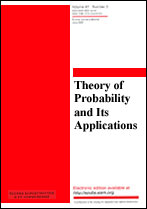|
|
Teoriya Veroyatnostei i ee Primeneniya, 1992, Volume 37, Issue 1, Pages 36–45
(Mi tvp4120)
|
 |
|
 |
This article is cited in 1 scientific paper (total in 1 paper)
Estimation of Induction Distributions with Doubly Censored Data and Application to AIDS
G. Gomez
Polytechnic University of Catalonia
Abstract:
We consider the nonparametric estimation of the distribution function $F$ of a real variable $T$ when $T=Z-X$, where $Z$ is a right-censored random variable and $X$ an interval-censored random variable. This sampling scheme, in which the origin time is interval-censored and the failure event is right-censored, was motivated by hemophiliacs who were unknowingly infected when the blood factor they received for their disease was contaminated with HIV. Since blood samples are periodically stored, these could be retrospectively tested to determine for each hemophiliac a time interval in which HIV infection occurred. Infected individuals remain seropositive and may eventually develop clinical AIDS. Our approach considers the time-to-AIDS as right-censored. The estimation of the infection time and the induction time are handled independently. We start by estimating the infection time distribution based on the intervals where the individuals were observed to be infected. Once a set of estimators for the infection time probabilities is derived, we can treat the interval-censored induction times as weighted exact induction times. We then estimate the induction time distribution.We first estimate the distribution of the infection time based only on the infection intervals without use of the knowledge of the time-to-AIDS, $Z$. In a sense, this is equivalent to estimating the marginal of the overall likelihood function. Then we estimate the induction time distribution conditional on the knowledge of the probabilities of being infected at time $x_j$. We propose a simple iterative procedure to obtain estimates for the infection weights based on the marginal likelihood. The estimates we obtain are maximum likelihood estimates and they estimate consistently the infection probabilities. To estimate the mass probability function for the induction time we derive the maximum likelihood estimator of the conditional likelihood using a self-consistency algorithm. Finally, we analyze a group of patients who were infected between 1978 and 1985 (when the test for antibodies to the AIDS virus was developed), and who were followed up until 1988.
Citation:
G. Gomez, “Estimation of Induction Distributions with Doubly Censored Data and Application to AIDS”, Teor. Veroyatnost. i Primenen., 37:1 (1992), 36–45; Theory Probab. Appl., 37:1 (1993), 32–39
Linking options:
https://www.mathnet.ru/eng/tvp4120 https://www.mathnet.ru/eng/tvp/v37/i1/p36
|


|




 Contact us:
Contact us: Terms of Use
Terms of Use
 Registration to the website
Registration to the website Logotypes
Logotypes








 Citation in format
Citation in format 
